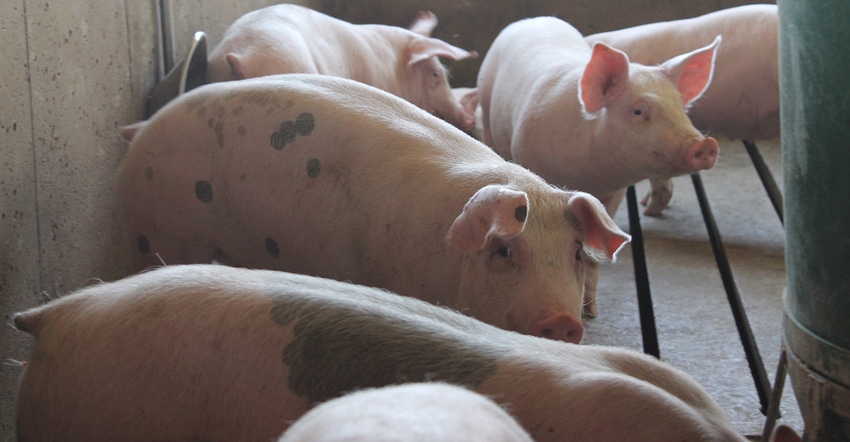USAHA passes resolutions to address African swine fever protocols
Resolutions call for valid sampling methods and protocols for feed and feed inputs, approval of swine oral fluids for diagnostics.
February 6, 2020

Nothing is more important to U.S. animal agriculture than protecting against foreign animal disease, and that threat has never been greater than it is right now with African swine fever. The virus continues to infect animals in Asia and Europe, and U.S. producers are taking every precaution to protect their herds. In addition, industry groups like the U.S. Animal Health Association have passed resolutions to improve testing methodologies for animals and feed; and develop protocols for movement and disease prevention.
The best decisions are made with collaboration and broad acceptance among a diverse group of stakeholders, and that's why the USAHA plays such an important role. Its members include producers, academia, private industry and government personnel, so no decision is made in a vacuum.
When animal-health issues arise, USAHA can address them quickly and appropriately, as it has with ASF.
"These diseases [like ASF] do not need a visa, and my take-home message to you is the importance of outreach," Juan LuBroth, a well-known expert on ASF, told veterinarians, producers and government officials at the 2019 USAHA meeting. He serves as chief veterinary officer for the United National Food and Agriculture Organization. He encouraged U.S. animal health officials to collaborate with their counterparts in other countries to stay on top of the virus's movement.
"It's not pretty," Lubroth said, referring to the impact of ASF. "The volume of pigs that have had to be disposed of is beyond the scope of these communities. In China… what has taken place is quite ghastly."
Several resolutions related to ASF and classical swine fever were addressed and passed at the association's meeting last fall. Neither of these viruses are zoonotic. They do not affect people, but both have genotypes that can cause 100% mortality so keeping them out of the U.S. pork industry is critical. Following are the resolutions:
ASF/CSF surveillance program and tissues for official ASF testing in National Animal Health Laboratory Network Laboratories
The USAHA urges the USDA Animal and Plant Health Inspection Service to validate and approve the items listed below to enhance the cost-effectiveness, sustainability and breadth of coverage provided by the ASF/CSF Surveillance Program. The USDA-APHIS ASF/CSF Surveillance Program at USDA, National Animal Health Laboratory Network laboratories shall:
Validate methods and implement a provision for using pooled samples for ASF/CSF polymerase chain reaction testing from case-compatible diagnostic case submissions.
Revise the premises identification number requirement so as not to exclude cases from the ASF/CSF Surveillance Program, provided traceability of the sample is assured.
FAD diagnostic capabilities and capacities at USDA-APHIS NAHLN laboratories shall:
Continue to expand the number of ante-mortem sample types (e.g., oral fluids, processing fluids, swabs, serum) approved for FAD diagnostic testing that are well suited for herd level detection and high-throughput test methods at veterinary diagnostic laboratories.
Expand the number of assays, testing methodologies (nucleic acid and antibody detection, and sequencing analysis) and reagent supplier options approved for FAD diagnostic testing conducted at USDA-APHIS NAHLN laboratories.
Valid sampling methods and protocols for feed and feed inputs
The USAHA urges the Food and Drug Administration, Center for Veterinary Medicine and USDA APHIS Veterinary Services to work with the U.S. pork industry to develop valid sampling methods and protocols to detect pathogens in foreign feed and feed inputs that can be applied at the point of embarkation to the U.S. or upon arrival at the port of entry.
Efficient diagnostic sample validation and approval for swine FADs
The USAHA urges the USDA APHIS Veterinary Services to work with U.S. pork industry to validate and approve swine oral fluids, swine processing fluids and meat juice for detection of antigen and antibody for CSF, ASF and foot and mouth disease.
FAD Prevention
The USAHA urges the Department of Homeland Security, United States Customs and Border Protection to:
On a quarterly basis, provide interdiction metrics to pork industry representatives.
Work with the FMD Cross-Species Team to develop education designed to increase awareness for passengers that are in transit from foreign ports into the U.S. on the importance of protecting agriculture and being truthful on the U.S. Customs Declaration form.
Work with the FMD Cross-Species Team to develop biosecurity education for travelers diverted for secondary screening after declaring they have been on a farm or in contact with animals in a FAD positive nation.
Modify the U.S. Customs Declaration form to include language regarding a traveler's proximity to packing and processing plants, live and/or wet markets, research facilities, laboratories, or any other location where there is a likelihood that cross-contamination could occur directly or indirectly between the traveler and animals, fresh animal products or animal excretions.
Stop movement – Criteria for implementing and releasing
The USAHA urges the USDA APHIS Veterinary Services to work with the U.S. pork industry and state animal health officials to develop criteria for implementing and releasing national movement standstills due to the occurrence of a trade- and commerce-limiting foreign animal disease of swine.
While the U.S. pork industry and USAHA take action on the home front, the FAO and its standing group of experts are building capacity to better address ASF and other FADs through epidemiology training, lab training, collection and identification and diagnosis.
Detection of ASF is not the issue, Lubroth stressed. "Reporting, disease containment and understanding the markets are the issues," he said. "The key to controlling African swine fever is biosecurity, biosecurity and biosecurity, and not necessarily in that order."
Source: U.S. Animal Health Association, which is solely responsible for the information provided, and wholly owns the information. Informa Business Media and all its subsidiaries are not responsible for any of the content contained in this information asset.
You May Also Like



